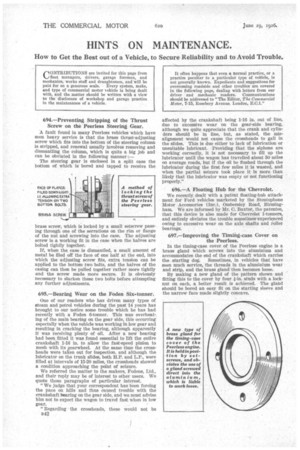HINTS ON MAINTENANCE.
Page 26

If you've noticed an error in this article please click here to report it so we can fix it.
How to Get the test out of a Vehicle, to Secure Reliability and to Avoid Trouble.
694.—Preventing Stripping of the Thrust Screw on the Peerless Steering Gear.
A fault found in many Peerless vehicles which have seen heavy service is that the brass thrust-adjusting screw which fits into the bottom of the steering column is stripped, and renewal usually involves removing and dismantling the column, which is quite a big job and can be obviated in the following manner :— The steering gear is enclosed in a split case the bottom of which is bored and tapped to receive the brass screw, which is locked by a small setscrew passing through one of the serrations on the rim or flange of the nut and screwing into the case. The adjusting screw is a working fit in the case when the halves are bolted tightly together.
If, when the case is dismantled, a small amount of metal be filed off the face of one half at the end, into which the adjusting screw fits, extra tension can be applied to the bottom two bolts, and the halves of the casing can then be pulled together rather more tightly and the screw made more secure. It is obviously necessary to slacken these two bolts before attempting any further adjustments.
695.—Bearing Wear on the Foden Six-tonner.
One of our readers who has driven many types of steam and petrol vehicles during the past 14 years has brought to our notice some trouble which he has had recently with a Foden 6-tonner. This was overheating of the main bearing on the gear side, this occurring especially when the vehicle was working in low gear and resulting in cracking the bearing, although apparently it was receiving plenty of oil. After a new bearing had been fitted it was found essential to lift the entire crankshaft 1-16 la. to allow the fast-speed pinion to mesh with its gearwheel. At the same time the crossheads were taken out for inspection, and although the lubricator on the trunk slides, both H.P. and L.P., were filled at intervals of 15-20 miles, the crossheads showed a condition approaching the point of seizure.
We referred the matter to the makers, Fodens, Ltd., and their reply may be of interest to other users. We quote those paragraphs of particular interest.
"We judge that your correspondent has been forcing the pace on hills and thus caused trouble with the crankshaft bearing on the gear side, and we must advise him not to expect the wagon to travel fast when in low gear.
"Regarding the crossheads, these would not be B42
affected by the crankshaft being 1-16 in. out of line, due to excessive wear on the gear-side bearing, although we quite appreciate that the crank and cylinders should be in line, but, as stated, the misalignment would not cause the crossheads to gall in the slides. This is due either to lack of lubrication or unsuitable lubricant. Providing that the siphons are working correctly, it is not necessary to fill up the lubricator until the wagon has travelled about 50 miles on average roads, but if the oil be flushed through the lubricator during the first few miles it is wasted, and when the partial seizure took place it is more than likely that the lubricator was empty or not functioning properly."
696.—A Floating Hub for the Chevrolet.
We recently dealt with a patent floating-hub attachment for Ford vehicles marketed by the Stentophone Motor Accessories (Inc.), Ombersley Road, Binningham. We are informed by Mr. C. Baxter, the patentee, that this device is also made for Chevrolet 1-tonners, and entirely obviates the trouble sometimes-experienced owing to excessive wear on the axle shafts and roller bearings.
697.—Improving the Timing-case Cover, on the Peerless.
In the timing-case cover of the Peerless engine is a brass gland which screws into the aluminium and accommodates the end of the crankshaft which carries
the -starting dog. Sometimes, in vehicles that have seen much service, the threads in the aluminium weal and strip, and the brass gland then becomes loose.
By making a new gland of the pattern shown and fitting this to the cover by four i-in. studs with a locknut on each, a better result is achieved. The gland should be bored an easy fit on the starting sleeve and the narrow face made slightly concave.




























